24 and 25 of May 2025, Lake Abbe and Tadjoura, Djibouti
A couple of very opposite but equally fascinating runs in Djibouti. One at sunset in the wild nature, amongst the chimneys in Lake Abbe. The other at sunrise in the maritime front of bustling Tadjourah.
TLDR; “too long, didn’t read”
- I just want to run! Take me to RUN.
- I have 1 minute. Take me to USEFUL INFORMATION.
- Running is my excuse for travelling. Take me to TRIP.
- Running is my excuse for eating. Take me to CARBOLOADING.
- I want to know what to read in the plane. Take me to ONE BOOK.
🌍 The trip 📷: What to see in Djibuti in 2-3 days
🇩🇯 The visa 🛂
You need to apply for an e-visa beforehand.
We did that and we got ours, providing hotels and flight information, in 2 days. Luckily the portal is really cool and fast, so well done Djibuti!
About Djibouti
Djibouti is a small country packed with big contrasts: volcanic landscapes, salt lakes, coral reefs, and cultural crossroads. Sitting at the junction of Africa and the Arabian Peninsula, it’s a land of ancient caravan routes, tectonic drama, and rich Afar and Somali heritage. From the lunar landscapes of Lake Abbe to the kaleidoscopic marine life in the Gulf of Tadjoura, Djibouti offers raw natural beauty and scientific intrigue in equal measure. It remains one of East Africa’s most off-the-beaten-path and captivating destinations.
We visited it in a the very hot season, May 2025.
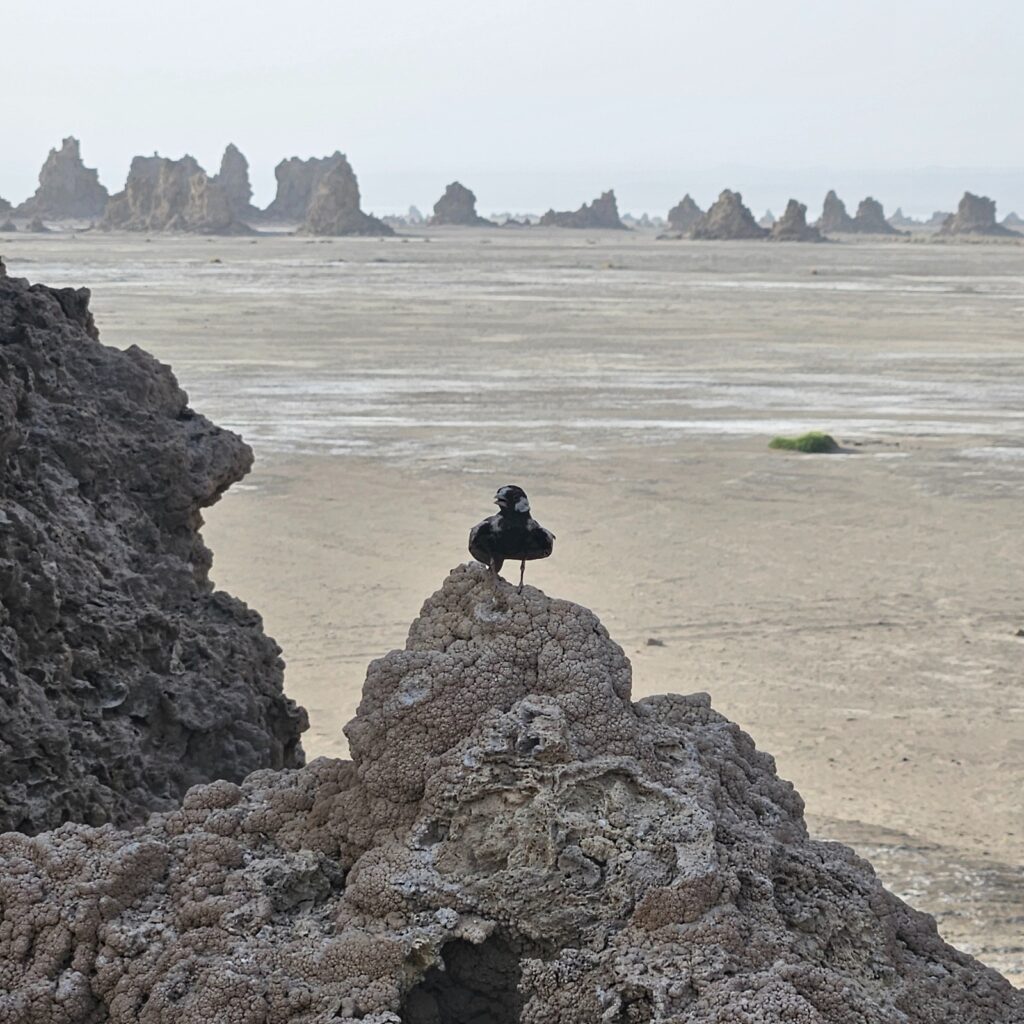
We arrived in Djibouti at 5:30pm in the afternoon and cleared customs without problems because we had applied for the Visa in advance.
Although you can also obtain a Visa on arrival. We saw a dozen French soldiers queuing for that. Later we would learn more things about the French army being in Djibouti. It’s the second force by numbers established here, after the Americans. They used to be the main one but the Foreign Legion left for Abu Dhabi a few years back.
The heat surprised us: it was intense even at this hour and our guide, Akram, explained that between 12 and 4 is almost unbearable, which we had the opportunity to feel.. or, should I say, suffer.🥵

Djibouti is famous in neighbouring countries for the heat and there are good reasons for that. In a couple of days we went to Lake Assal, the lowest point in the whole continent, and we would have 48 degrees celsius!! 🥵 🔥
The following day, our guide Akram picked us up at 8am and we had a long day drive to Lake Abbe on the western frontier.
First Impressions
We saw people bathing on the beach, already at 8am, with a massive oil tanker vessel on their backs. Not a tropical sight but curious enough.
It was Saturday, a festive day here as they follow the Muslin calendar.
Akram explained many things. For instance, that the city is divided into African and European quarters, and that there were big differences during colonial times. Or that the streets in the European quarter are named after European cities, including Madrid 😉
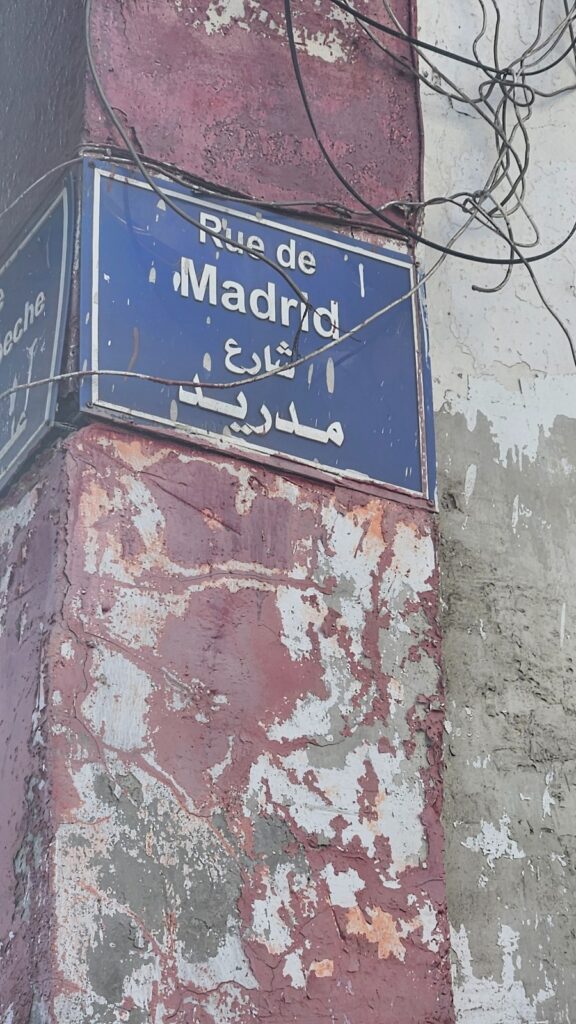
We passed by the old port and we saw docks, and the precarious housing typical to African cities with a lot of dust. Dust and rocks and weak trees and plastics dumped everywhere.
Akram complained about the amount of waste and explained that they now banned plastic bags but they should do the same with plastic.
Gosh, they should:
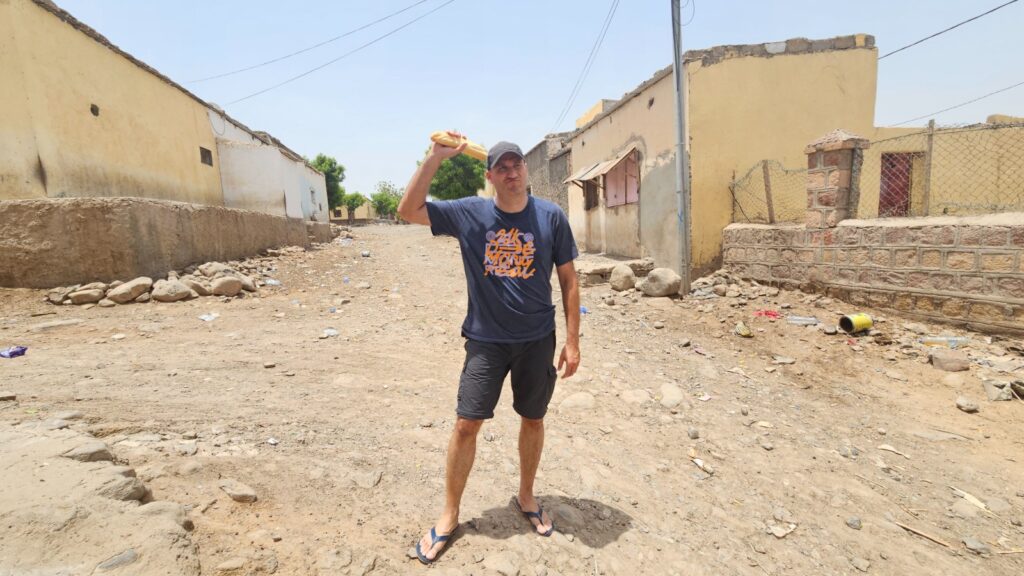
Djibouti city seemed to me like a typical African city but here there were warehouses, Maersk containers and cranes and barbed wire and trucks. Akram explained about imports and exports of oil and timber and everything: 70% of Djibouti’s economy is related to its harbour!
Ops! Trouble with the police!
I was happily taking pictures of the place as I always do, in this case of the dusty ugliness surrounding me, and I caught a glimpse of a police station, a “Gendarmerie”. And they saw me!! 😡 They asked us to stop and a very angry policeman took my phone. It was “confiscated”
Djibouti is a military place and they take very seriously the possibility of terrorists and spies disguised as tourists.
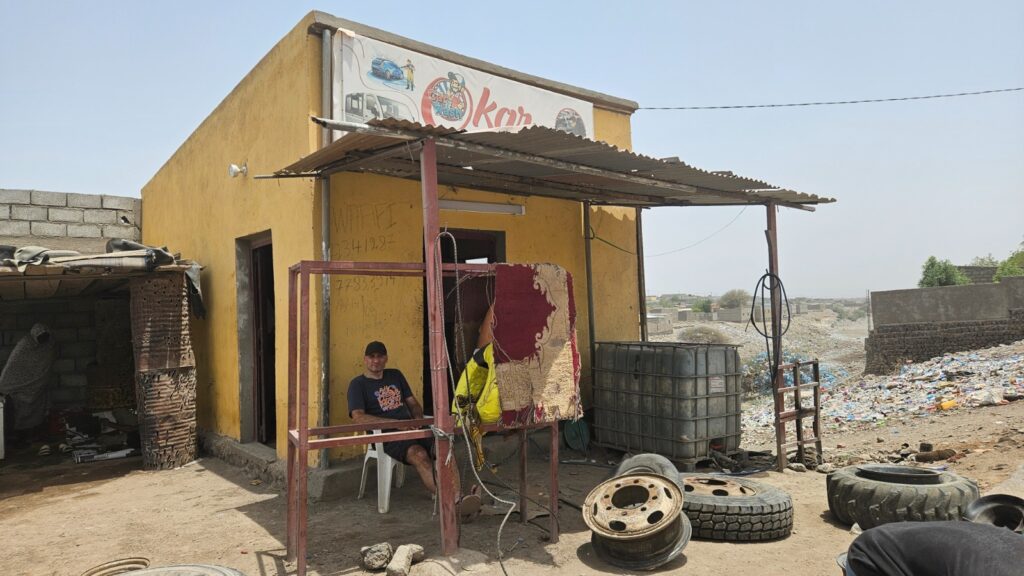
Of course one can wonder what kind of shitty spy takes a picture of a traffic stop with a few bored policemen controlling Tuk Tuks, but, still… I was at fault.
The driver kept telling us “we are in deep trouble” as an angry policeman went away with my confiscated phone 😰
The following hour we spent in the Gendarmerie where they asked for our passports and threatened us: “you are going to jail, you are going to court”, said Abdala, “the bad cop”, while another guy in sandals was asking him to calm down.
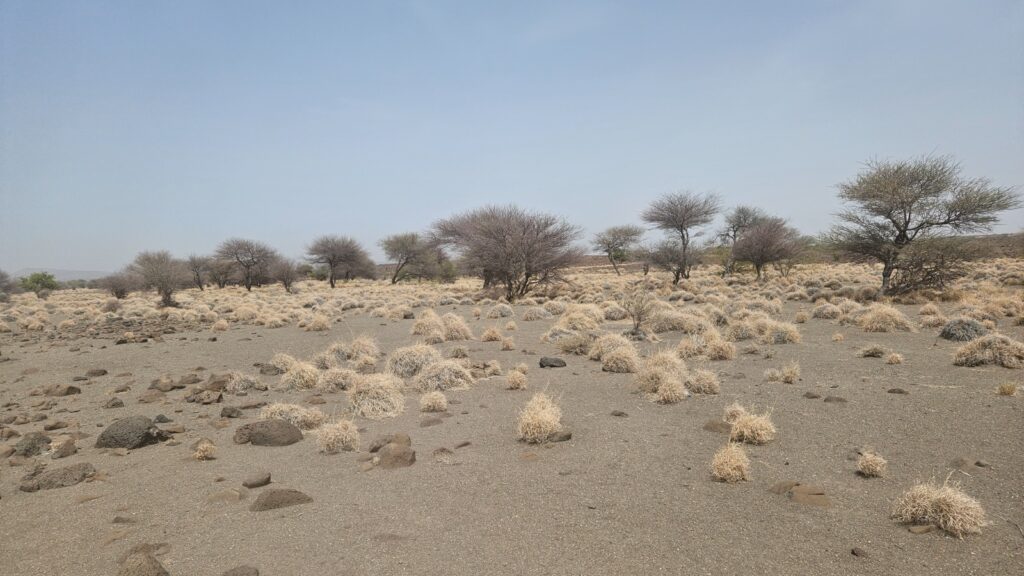
It was a good cop / bad cop routine while we apologised profusely “pardon, pardon, we did not see the gendarmerie”.
I could already picture myself being expelled from the country and my phone confiscated, or worse: what if they would let us out of the country and put us in jail…?

But finally and after paying an unofficial “fee” 😣… we could recover our passports and my cell phone (what a relief!) and they sent us “a la voiture” and we could go.
The Grand Bara 15kms
While we passed by the Grand Bara desert, Akram explained that a “marathon” is organised every year here, in January.
We could see a row of stones that marked the course!
Intrigued, later we looked it up on the internet: it is actually a 15kms race organised by the French Army, “Le cross du 15 kms”.
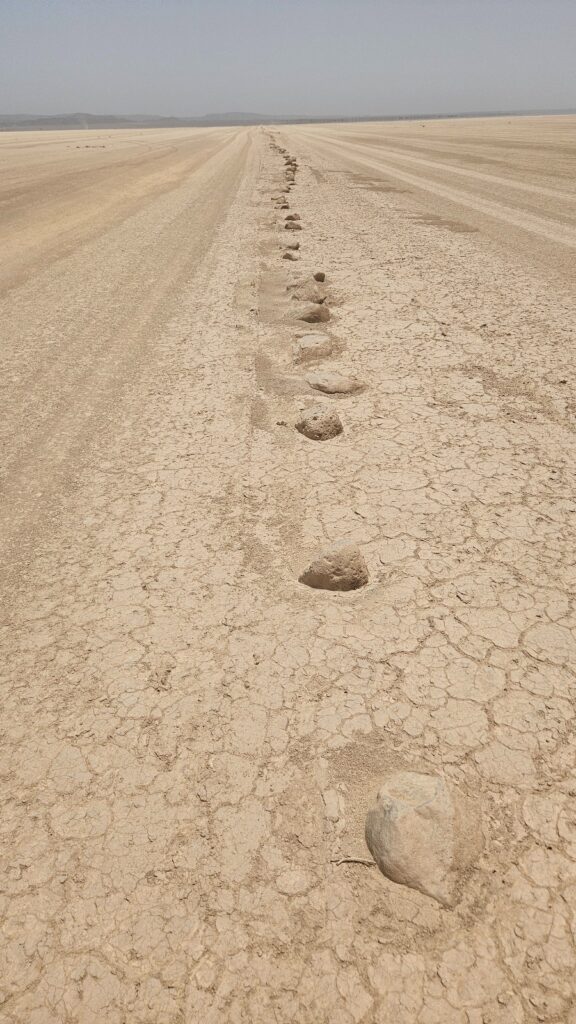
We promised Akram that we will come here to run it, and we plan to do it!
The Tribes in Djibouti
During our trip, our guide Akram explained about the Issa and the Afar tribes in Djibouti.
The Issa and Afhar (Afar) tribes are two of the most prominent ethnic groups in Djibouti, each with distinct cultural identities and historical backgrounds. The Issa are a sub-clan of the larger Somali ethnic group, while the Afar belong to the Cushitic-speaking peoples of the Horn of Africa.
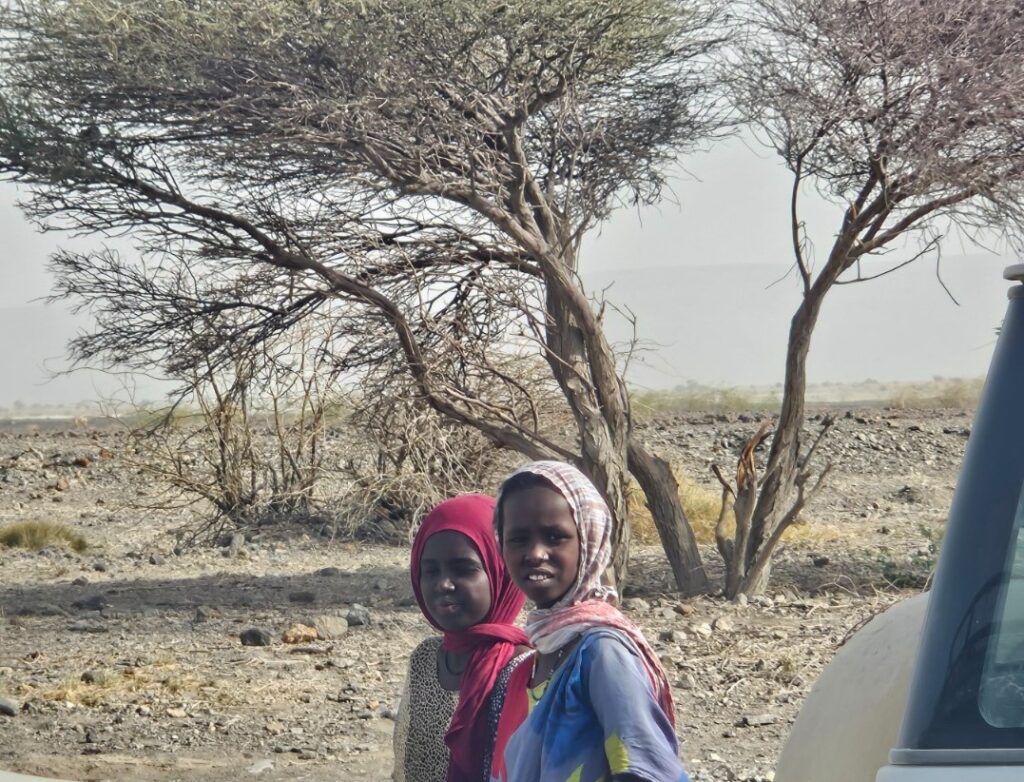
Both groups have deep roots in the region and have traditionally lived as nomadic pastoralists, although urbanization and modernization have significantly influenced their lifestyles in recent decades.
The architecture on the way to Lake Abbe: 🛖 Afar Huts (Aqal or Arish)
And also during our long drive we saw many ‘towns’ in the middle of the desert and I was fascinated by the huts.
Often referred to as “arish” (also used in coastal Djibouti) or nomadic Afar huts. They are dome-shaped or beehive-shaped portable huts constructed with bent sticks or palm ribs, covered with mats woven from palm fronds, grasses, or animal hides.
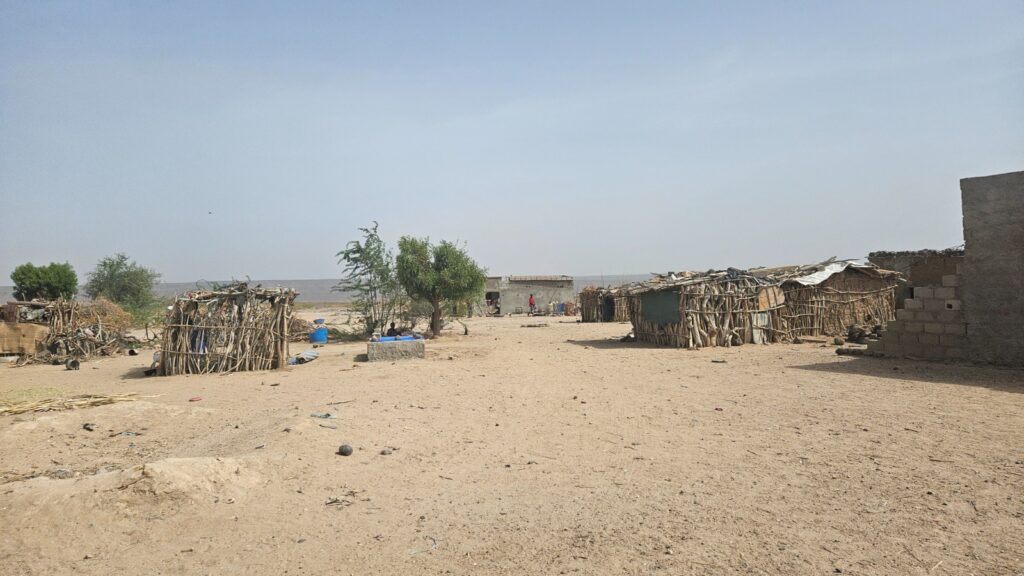
Akfram explained that these huts are semi-permanent or portable, reflecting the Afar’s semi-nomadic lifestyle.
They are designed to be dismantled and moved as pastoralist families migrate in search of water and grazing.
Lake Abbe Campsite
Word of caution! Lake Abbe is one magical experience, but the campsite As Bolé, the only one in the area, is very basic.
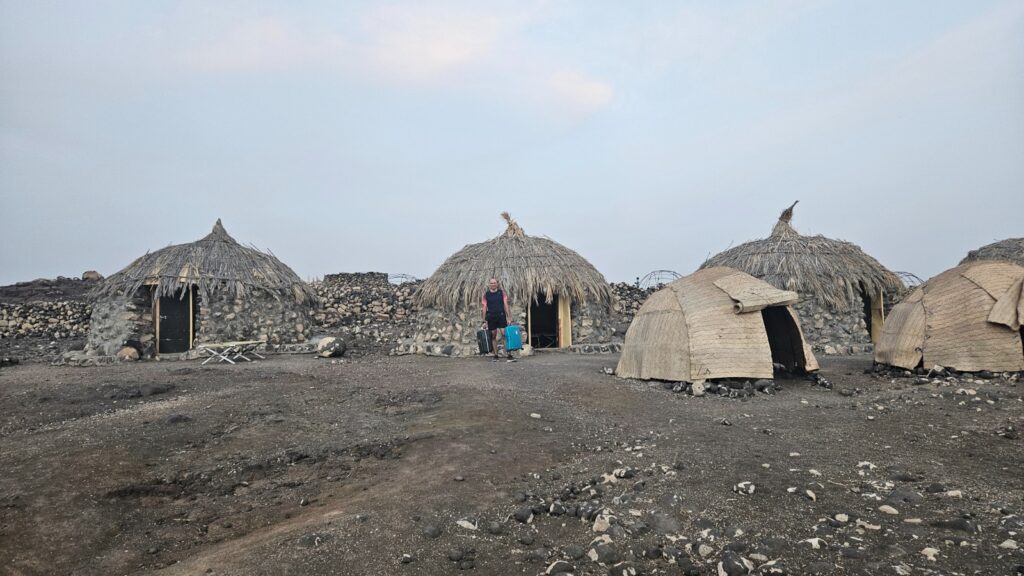
For me, it is totally worth it, but do not expect a luxury campsite.
Plus, we found giant spiders in the toilets and the showers! This was ‘wild’ in many aspects 🙂
Anyway I enjoyed it massively also because we were the only guests apart from a Danish guy living in South Korea, with whom we shared dinner and stories, along with our guides.
Loved hearing all the stories about the ‘African way of thinking’, about the American army people who are the main clients for the tours, and about the ‘crazy Russian tourists’.
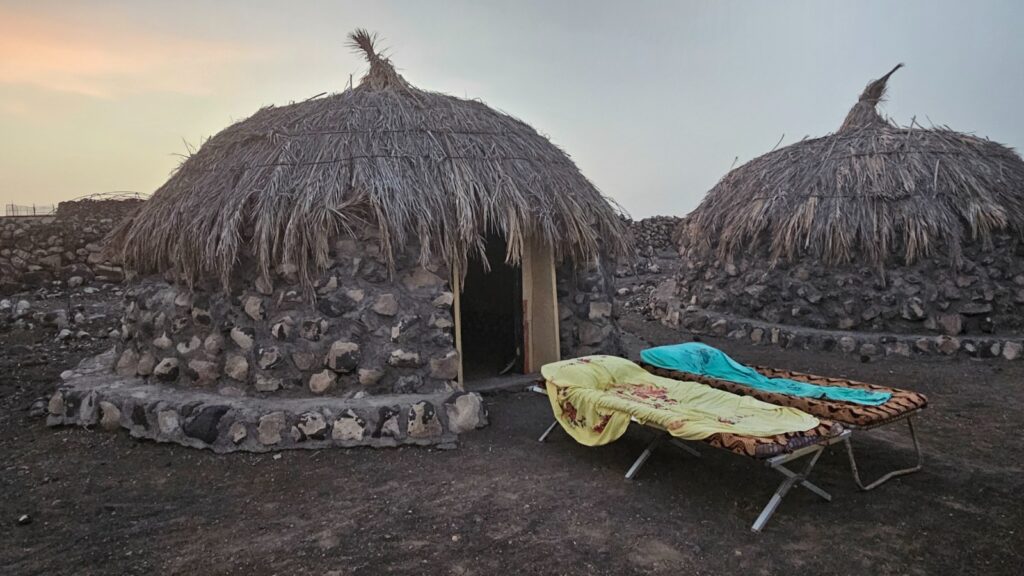
As Bolé Camp staff are friendly, they cook good food (we ate pasta, but local style!) and the place offers traditional huts as bungalows: made with wood and straws and basalt rocks. These rocks absorb the heat during the day… but they expel it at night.
So, as a consequence, our ‘room’ was boiling at night and we decided to do like all the locals did: we brought our beds outside and slept under the stars!
It was so special, I kept looking at the starry sky and thinking how magical the experience was.
Lake Assal, the canyon of the Rift and the Volcanic Region
After a magnificent sunrise in Lake Abbe, the following day we drove from Lake Abbe to Tajourah, passing by Lake Assal, The Canyon of the Rift and the volcanic region.
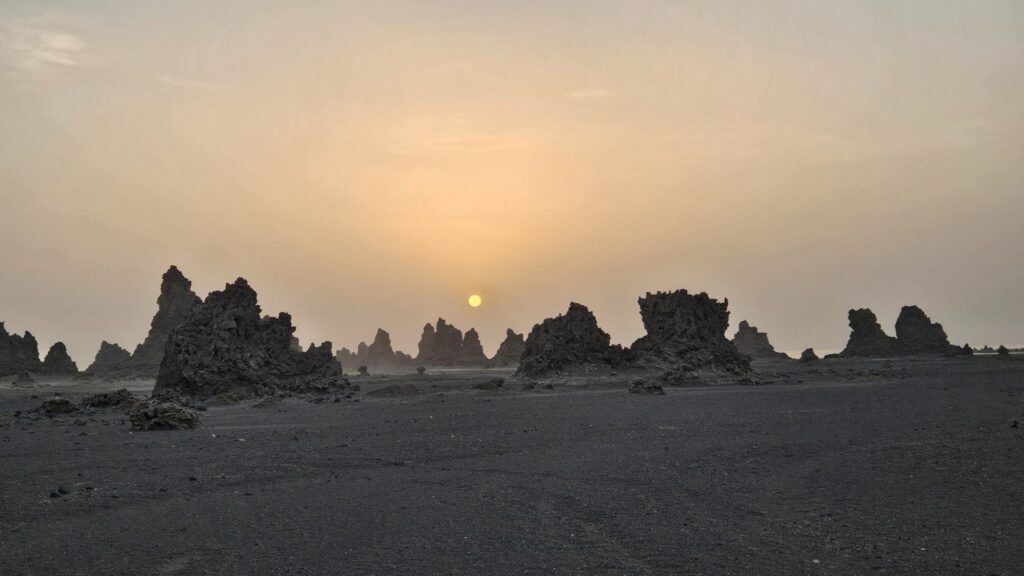
It was an extremely tiring drive, made worse by the extreme heat, but, still, again it was worth it.
We did it on the 25th and 26th of May and apparently these two days were the hottest of the whole year!
Lake Assal
When we stopped at Lake Assal… we had 48 degrees!
Lake Assal is one of the most surreal and spectacular destinations in Djibouti, offering us the chance to stand at the lowest point in Africa (155 meters below sea level) and witness a dazzling salt lake surrounded by blinding white salt flats, turquoise waters, and volcanic landscapes.
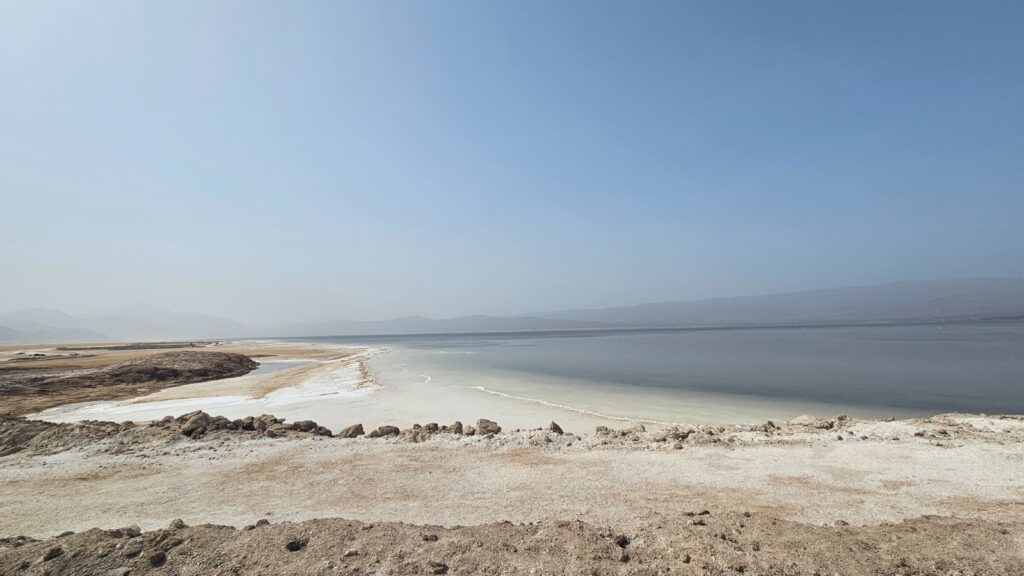
I found it to be an otherworldly beauty.
This time, we did not go in, but surely we would have floated, as this is an ultra-saline lake—saltier than the Dead Sea! (where we bathed when we ran the Petra Marathon, and we floated).
The Canyon of the Rift
The Canyon of the Rift, often referred to as part of the Great Rift Valley in Djibouti, is a dramatic geological wonder where we could physically see the Earth’s crust splitting apart.
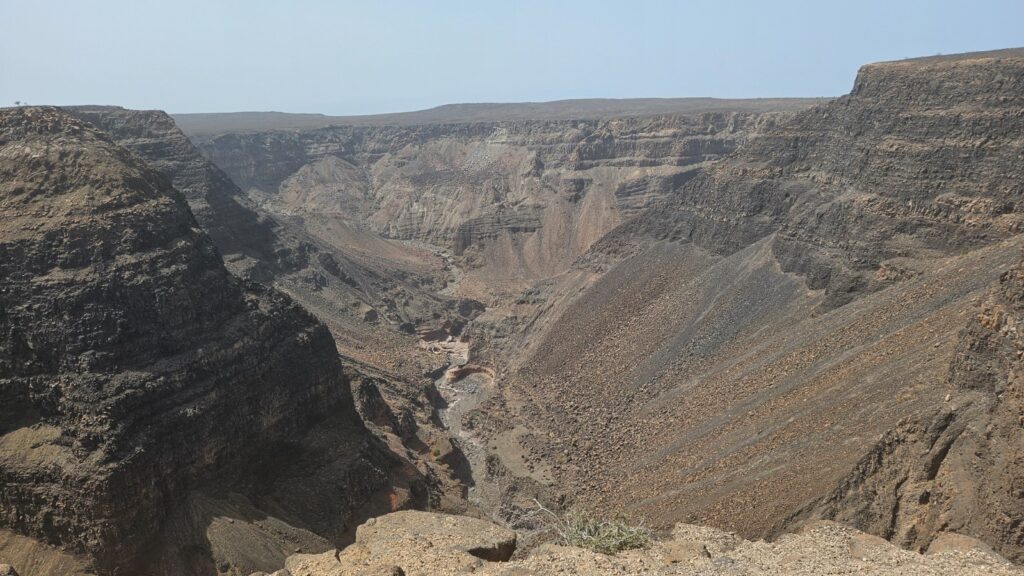
We enjoyed the towering cliffs, deep fissures, and the rugged terrain which showcase the raw power of tectonic movement. Apparently it is one of Earth’s most active rifting zones!
The volcanic region from Dikhil to Tadjourah
And finally we crossed the volcanic region from Dikhil to Tadjourah.
It was a breathtaking journey through raw, untamed terrain marked by black lava flows, extinct craters, steam vents, and surreal geothermal features.
This is a place where science, natural beauty, and cultural encounters with Afar nomads all come together in a uniquely intense and immersive travel experience.
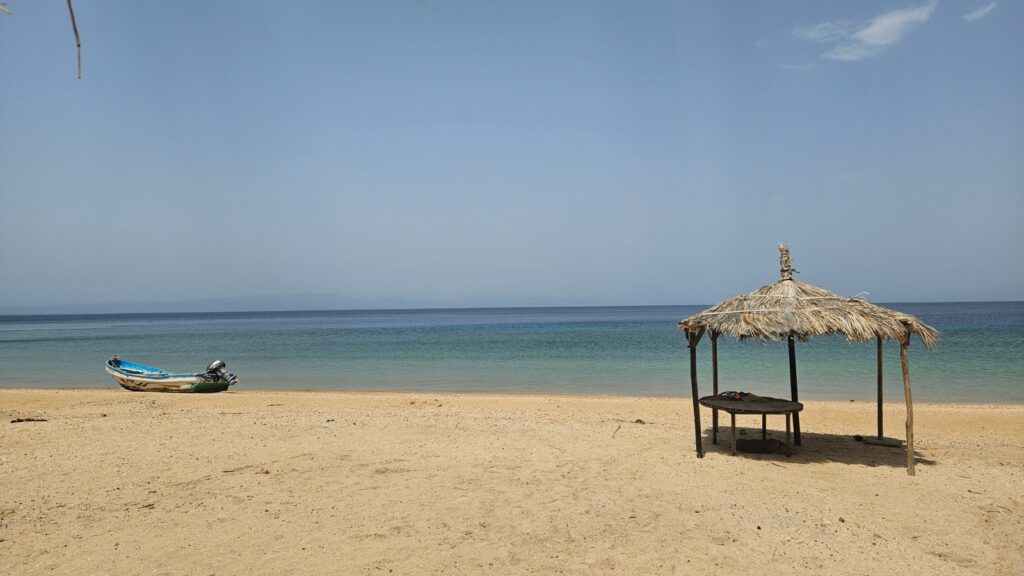
Djibouti City
Our final day we spent relaxing at the pool of the hotel and doing a city tour, including a pass-by tour of the main military bases.
Of course, I didn’t take any pictures of anything even resembling something military or police-related!! 😇
Near the new railway station there was a “Gendarmerie” where we had to stop. The policeman was chewing chat and he angrily asked if we had a camera. My Gosh! Why is it that all the “Gendarmerie” seems to care about in this country are pictures?🤔
Akram said it might have to do with the fact it is forbidden for them to chew chat and they might be scared to be caught on camera 😇 Whatever!
It was still extremely hot 🥵 and apparently the government issued a warning for people to drink water and not go outside from 12 to 4pm 😲. So we stayed in the car.
We saw the Old Parliament, which is now the “Palais du People” (National Theater), churches and mosques.
Last thoughts
Djibouti city didn’t seem to me particularly enchanting or different than other African cities we have visited. What I found curious is that in the European Quarter, sitting in the streets there were many ladies exchanging money 🤑
… And all of them were super big! The biggest we had seen in a country where pretty much everyone is super slim.
Even our flight back to Adis Ababa was extremely hot 🥵.
A woman dressed in a traditional robe who was praying before take off started watching “The Residence” in her tablet. And I say “curiously” because we probably were super different, professing different faiths and living completely different lives, but I also enjoyed the series and I laughed in a very similar way.
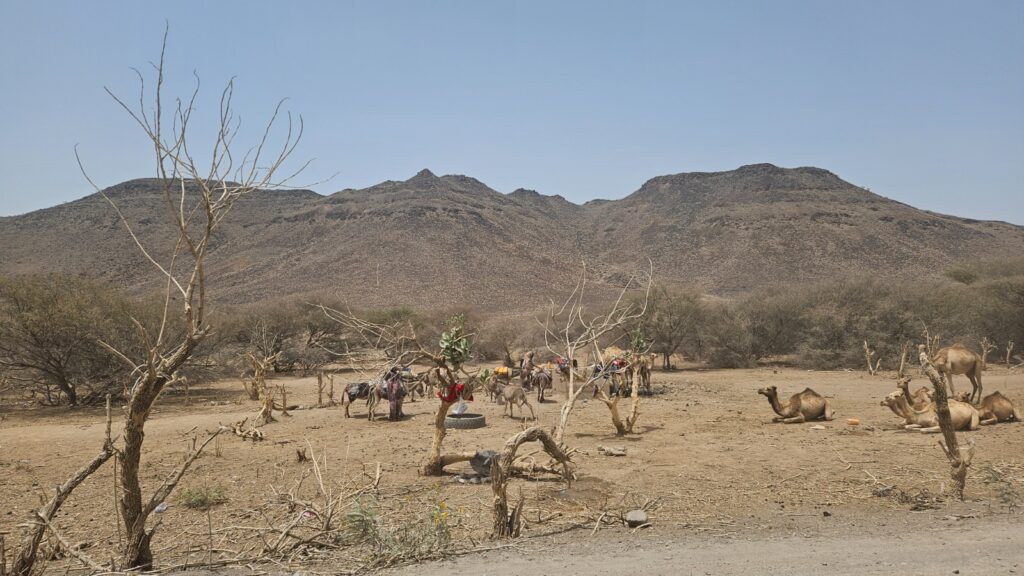
And I couldn’t help but think that I love travelling not only to see marvelous landscapes and historic landmarks, (specially as I love history 🥰) but also to understand better what is going on in this wide world we live in.
Talk with people, discuss opinions and see different perspectives. I am always surprised how the view of people of different cultures varies. It helps me gain perspective. There is so much more in this world than what we read in our local newspapers or in X, or see in Instagram.
🏃♀️ The run 🏃♂️
The Run in Lake Abbe
Lake Abbe, straddling the border between Djibouti and Ethiopia, is one of the most surreal landscapes in Africa.
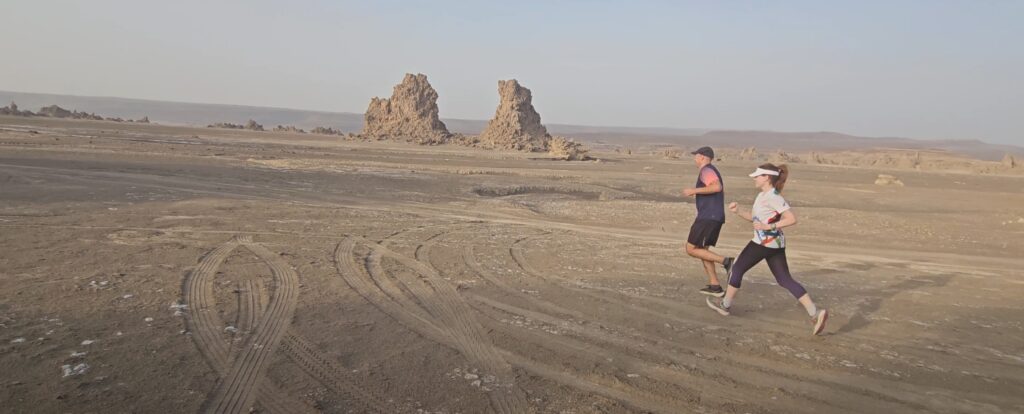
This hypersaline lake is best known for its forest of limestone chimneys—towering, steam-spewing formations that were created by geothermal activity beneath the rift valley.
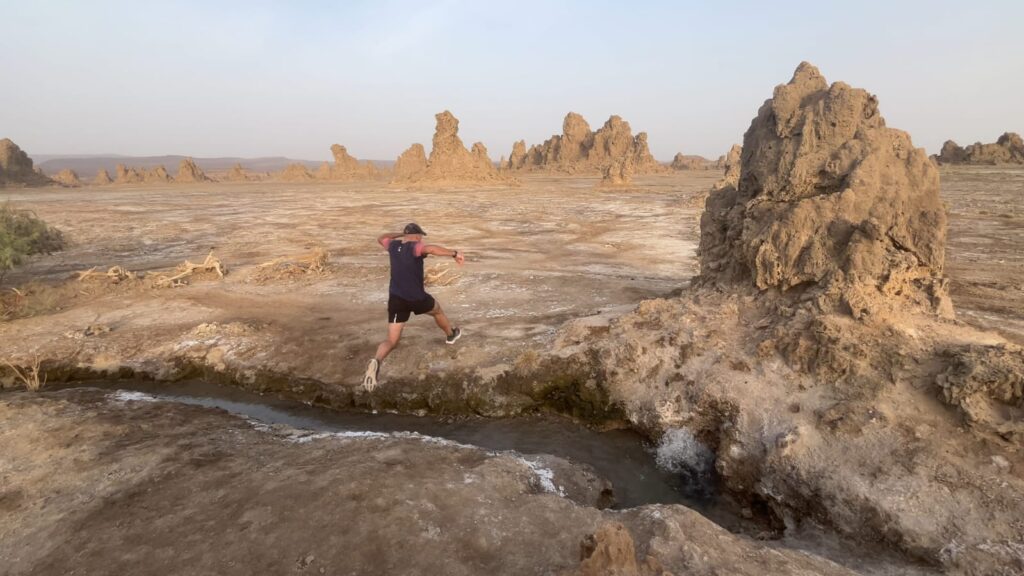
These alien-like structures, some reaching over 50 meters high, give the landscape a dreamlike quality, especially at sunrise or sunset when the light casts dramatic shadows. It’s a remote and otherworldly destination that feels like stepping onto another planet.
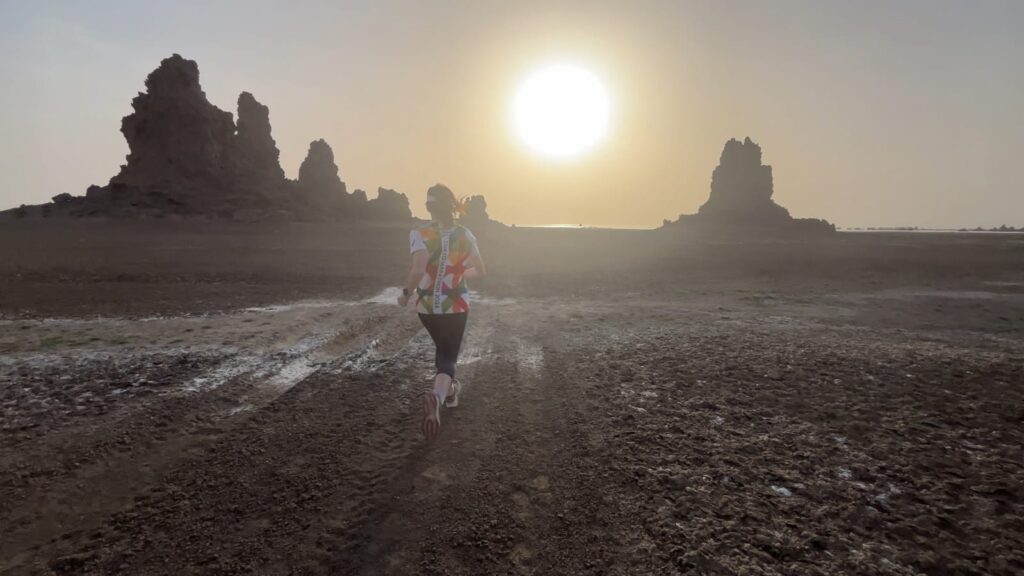
Running amongst the chimneys, by ourselves at sunset, was one of the best runs we have ever done.
Run Details and Logistics
We ran from 5:30 to 6pm approximately, 3.5kms in total.
It was still very hot, and we did bring a bottle of water with us. It is totally mandatory to bring hydration when you run in Djibouti in May.
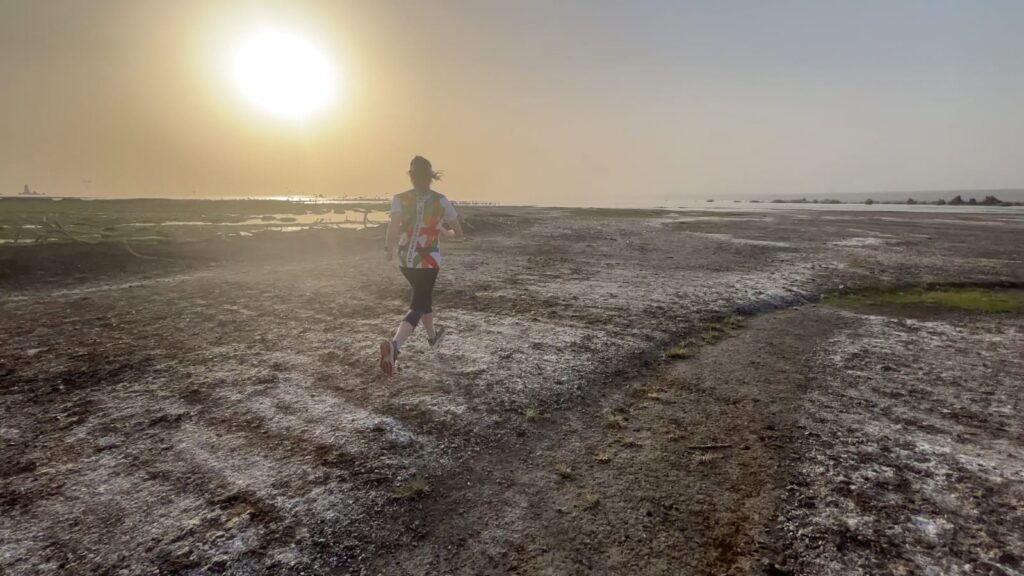
Akram had warned us not to run over the ‘wet parts as sometimes there’s quicksand, but, other than that, it was a very relaxing run. Quicksand, a saturated, loose sand that loses its supporting capacity and behaves like a liquid when disturbed, reminded me of movies with heroes disappearing engulfed by the earth.
The sand creaked under our footsteps.
We crossed extensions of salt mixed with the brown earth. It was easy to run, quite comfortable and even more magical.
I loved the complete silence other than the creaking!
The experience
It was not just about the visuals—it was a rare geological experience. The area lies within the Afar Triangle, a tectonically active region where three tectonic plates are slowly pulling apart.
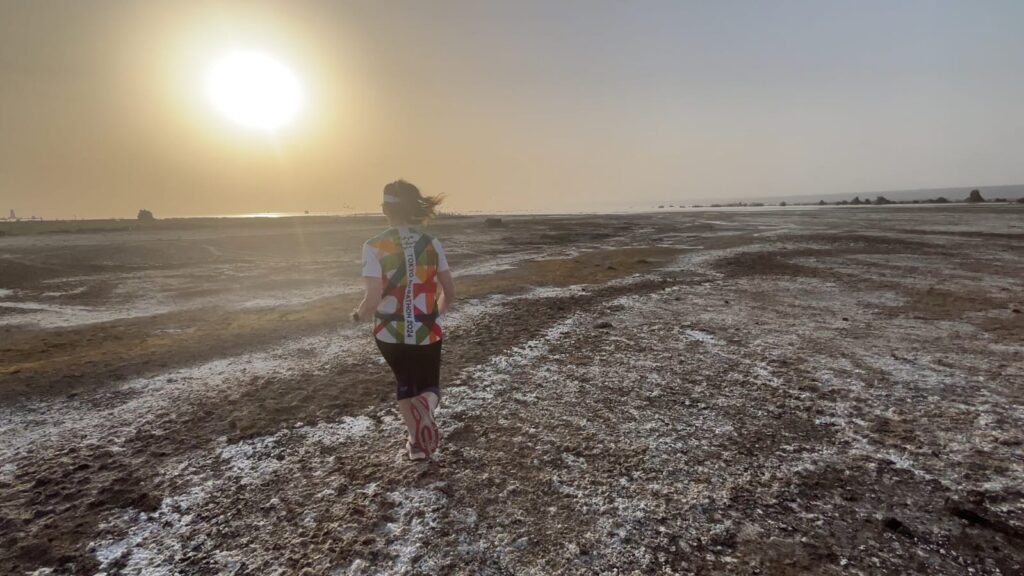
This makes Lake Abbe one of the few places in the world where you can witness the Earth’s crust in the making. The steaming vents and hot springs around the lake add to the mystique. I was running and thinking at the same time how lucky we were to be able to run here.
We ran along springs of boiling water with magma gas, which was so cool! And Roger even dared to jump on top of the spring.
And I remember while we were here that Akram told us that the original “Planet of the Apes” was shot here! But, was it?
Were we in the Planet of the Apes?
The internet told us that it is “a rumour that it was used as a filming location for the original ‘Planet of the Apes’. While the landscape of Lake Abbé is certainly visually striking, with its chimneys and salt flats, there is no evidence to confirm that any scenes from the movie were actually shot there”
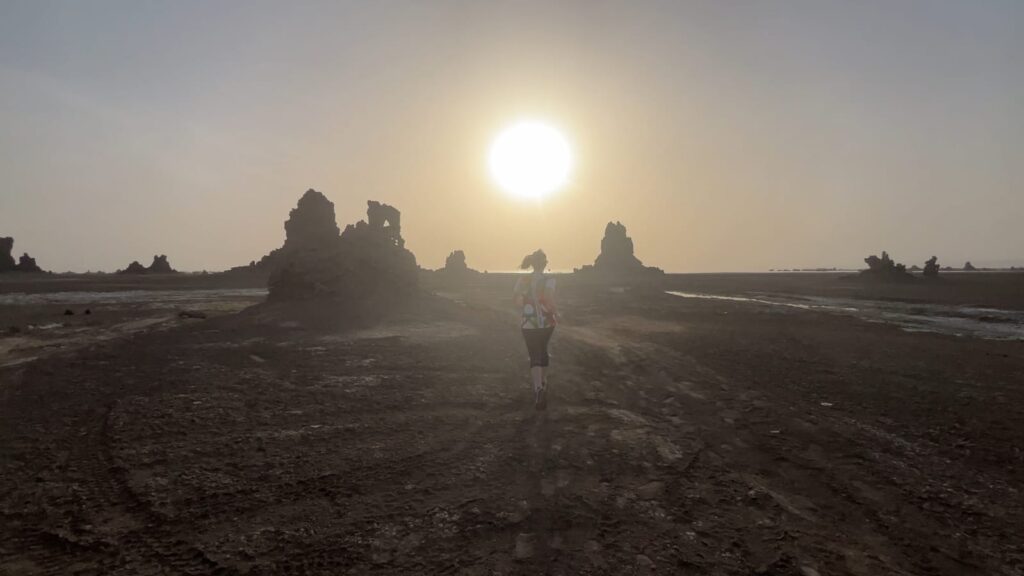
But it is a widespread rumour which even features in this article in the Hufftingon post which I found it very good and funny. It starts with “The next time you drop into Djibouti on the Horn of Africa — as I’m sure you all intend to — exit the airport, rent a 4X4 and keep going about 120 miles southwest across one of the harshest and hottest spots on Earth. You’ll eventually come to Planet of the Apes, the stark and remote reputed location for one of films in the cult series”
Anyway we continued running and enjoyed our run massively.
The fauna
When we got to the Lake itself, we saw what Roger thought were “coyote footprints”. And later, while we were filming a video, we did see it! A coyote!
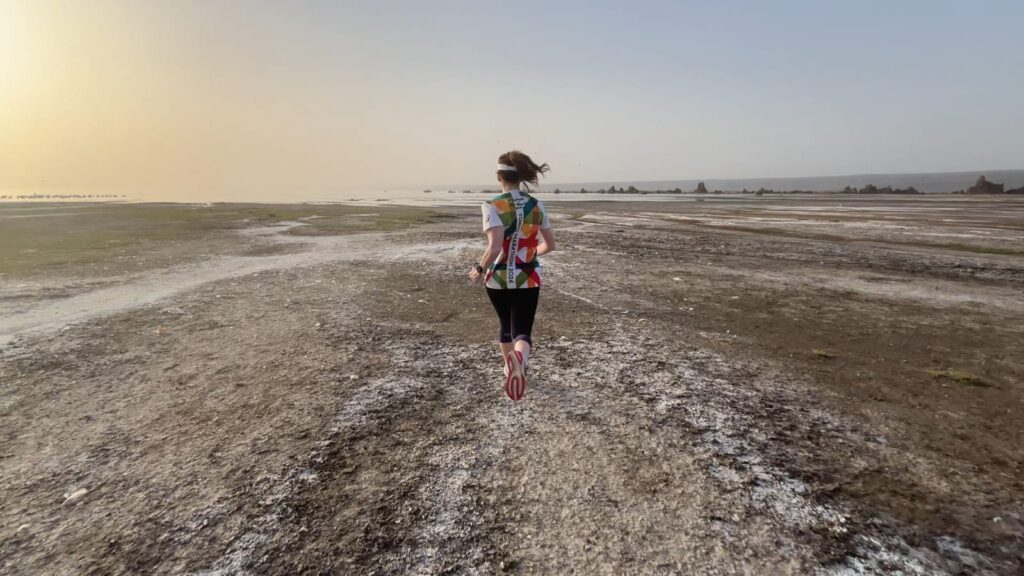
It turned out that it was not a coyote, but a fox. Akram told us they are not dangerous, they are “shy”.
Later I googled it and found out that there are foxes such as the Fennec fox and possibly the Rüppell’s fox in the area. These foxes are well adapted to arid desert climates and are typically nocturnal, using their keen senses to hunt small rodents, insects, and reptiles.
Basically: despite its harsh, volcanic environment, Lake Abbe supports a surprising variety of fauna, especially birdlife and some adaptable land mammals.
Among the most notable bird species found around the lake are the Egyptian geese and ibis.
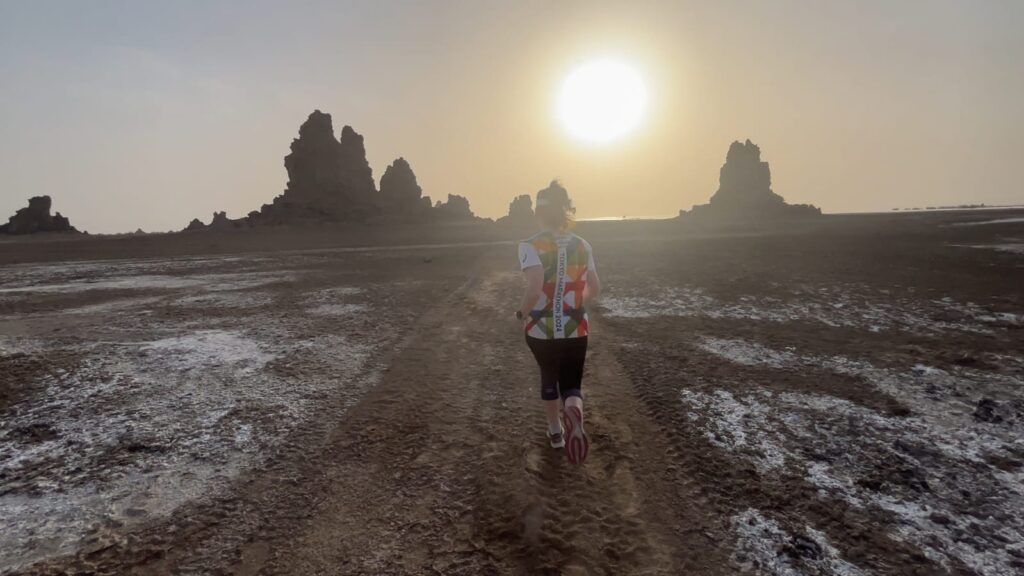
And when we got to the lake, we did see Egyptian geese and ibis!
Egyptian geese are large, distinctive waterfowl with striking brown and cream plumage, often seen in pairs or small flocks along the lake’s shoreline. They are drawn to the wetland areas around the lake where they feed on grasses, seeds, and small invertebrates.
And Ibises, especially the sacred ibis, are also common in the area. With their curved beaks and white-and-black feathers, these wading birds feed on aquatic insects, small fish, and crustaceans, thriving in the saline marshes that surround Lake Abbe.
The Run in Tadjourah
Tajourah is a historic coastal town on the Gulf of Tadjoura, east of Djibouti City. Known for its whitewashed buildings and laid-back atmosphere, it was once a key port for the Afar Sultanate and a vital part of regional trade routes.
We ran at sunrise and we got a glimpse into traditional Djiboutian life in its scenic seaside promenade.
Scenic here might not be what you expect, though.
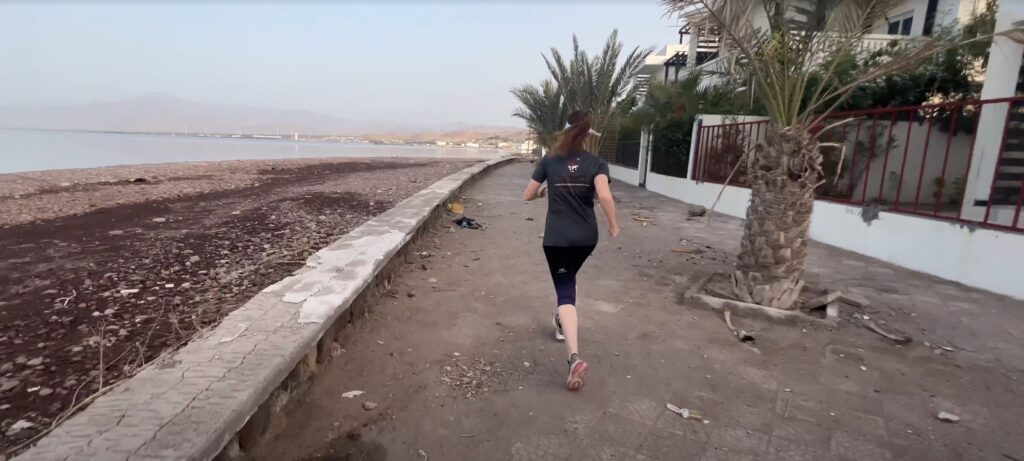
Don’t expect wide, clean avenues with palmtrees 🌴 and ice cream shops… 🍦
The “seaside” here is busy, extremely dirty and functional. People live here (literally: we saw a few urinating or even defecating🫨), animals walk free, there are abandoned vehicles and plastic dumps everywhere…
We even saw a sheep climbing on an abandoned truck and couldn’t resist to take a picture! 🤣
Run logistics
We ran 5,1kms, from 6:35am to 7:20am approximately: around 42 minutes.
And we made the mistake of not bringing water with us.

We almost paid a dear price at the end, as it was already very hot. In fact, we rushed it at the end with Roger remembering Cartagena de Indias, when we had to stop due to the heat.
So, again: always bring hydration when you run in Djibouti in May!
The city wakes up
Despite the heat, it was such a cool run, though.
The city was waking up and everywhere, we found people sleeping in the streets.
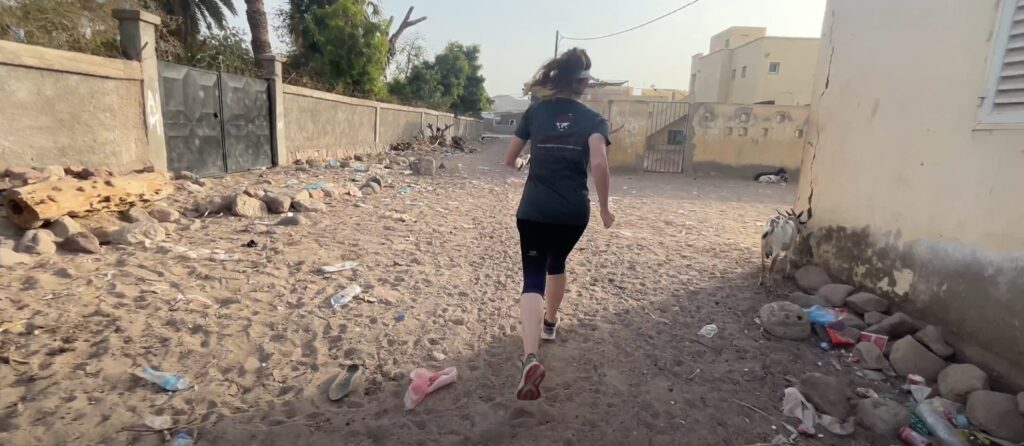
They do it because of the heat, as we could experiment the day before, when we had ourselves slept under the stars.
The animals were also waking up!
We ran with the sound of rosters crowing and we saw all sorts of animals. Crows (drinking in a puddle of water and flying away as I ran past them), seagulls, sheep (a lot of them!), cows…
Also dogs, but only in the very expensive villas in the seaside, which probably belonged to foreigners.
The locals
Locals were also starting to wake up. We literally saw a fee waking up from having slept outside, lazily moving their arms.
We crossed with all kinds of people: young guys who looked at us funny, old men who looked at us like we were aliens, and a woman completely covered in black apart from her eyes, who I also ran over… she was carrying a “baguette”.
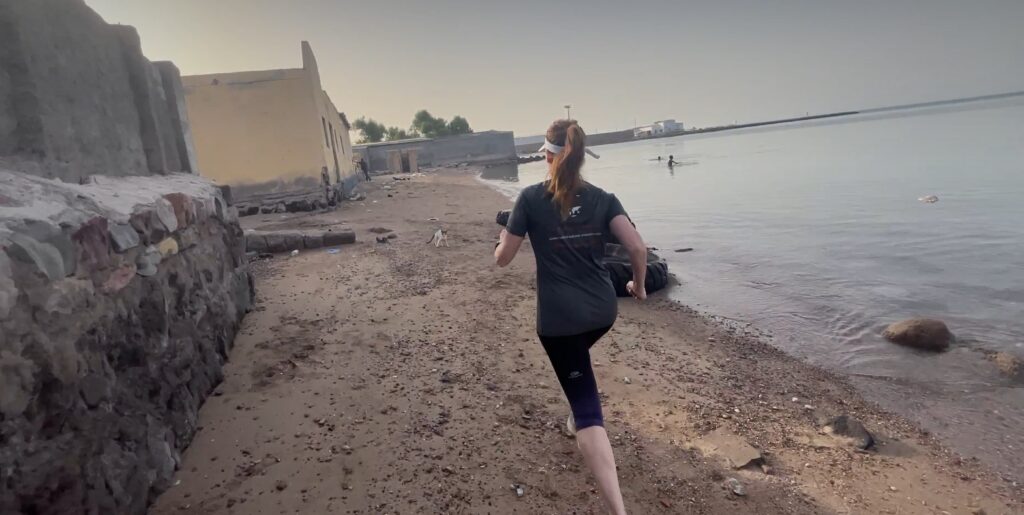
And I remembered that Akram said: “The only two things that the French left here was the language and the baguettes!”.
I would say, maybe also the “patisserie”, because in Djibouti you can find everywhere “pain au chocolate” and “chocolate croissants” and very good cakes
In general, though, people would not interact with us. It was not like in Lalibela, where everybody engaged with us, specially the kids.
Only two kids who were bathing in the sea shouted the usual “Bon jour, bon jour!!” and lifted their arms doing the “Usain Bolt sign” trademark. Which I did back, of course!
We also saw a guy with the Spanish National Football Team shirt, “la roja” 🇪🇦, and in the back the name of who appears to be the most famous player now, Lamine Yamal. He was not very interested in us.
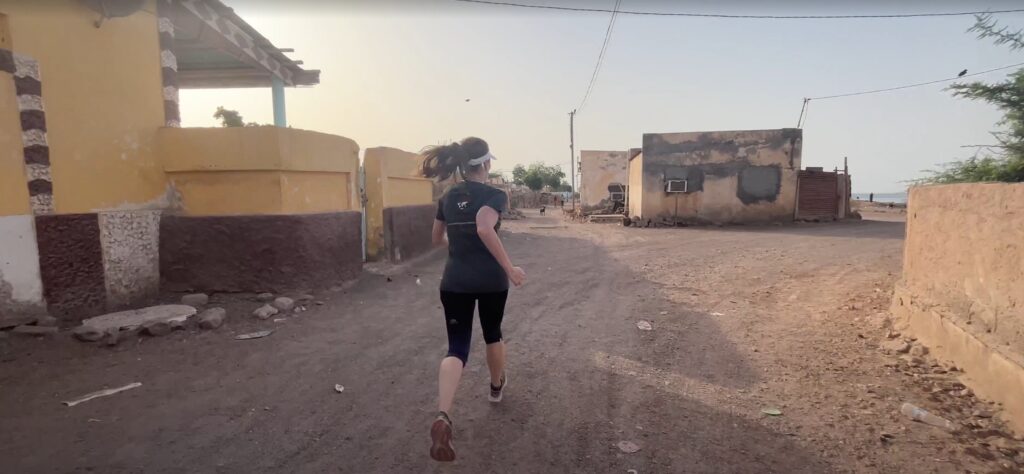
Again and as Akram had said, people of Tadjoura do not care at all for foreigners.
The port and an unexpected toilet
We passed by the port, with their dhews and fishing boats. Young guys very sleeping and others already bathing in the dock.
The water looked surprisingly clean. Especially as the shores were not!
Later we reached a beach and we ran across a part of this beach which was filled with rocks. And here we found a local, an old man, relieving himself … 😅
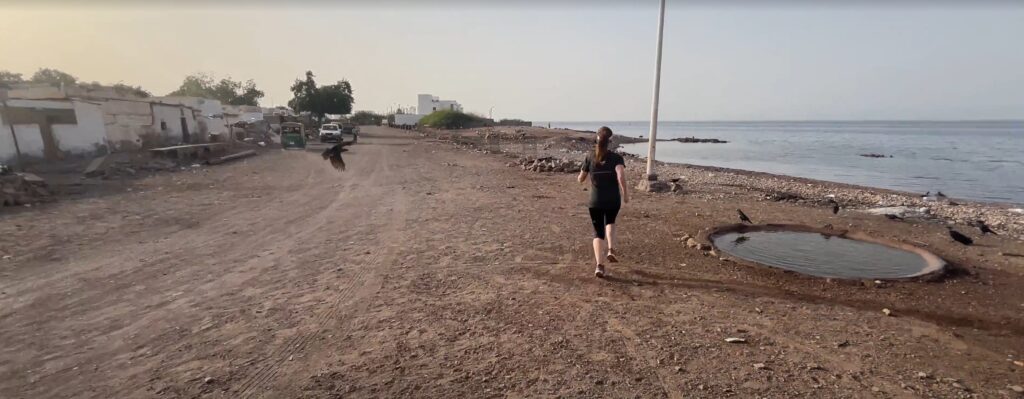
Luckily Roger stopped filming just before, otherwise we would have caught on camera this “unexpected” version of a toilet 💩 in the “seaside”.
Finally and as it was getting hot, we headed to the hotel, where we had water and air conditioning! ❄️
🍜 Carboloading 🍝: What to eat in Djibuti if you are a runner
Somali Tea
On the way to the airport, our guide Akram treated us to a very special tea in his house, shaah, the “classic somali tea”.
It was sweet and thick and delicious, and I burnt my tongue but I enjoyed it.
It is made with custard powder, milk, vanilla and spices.
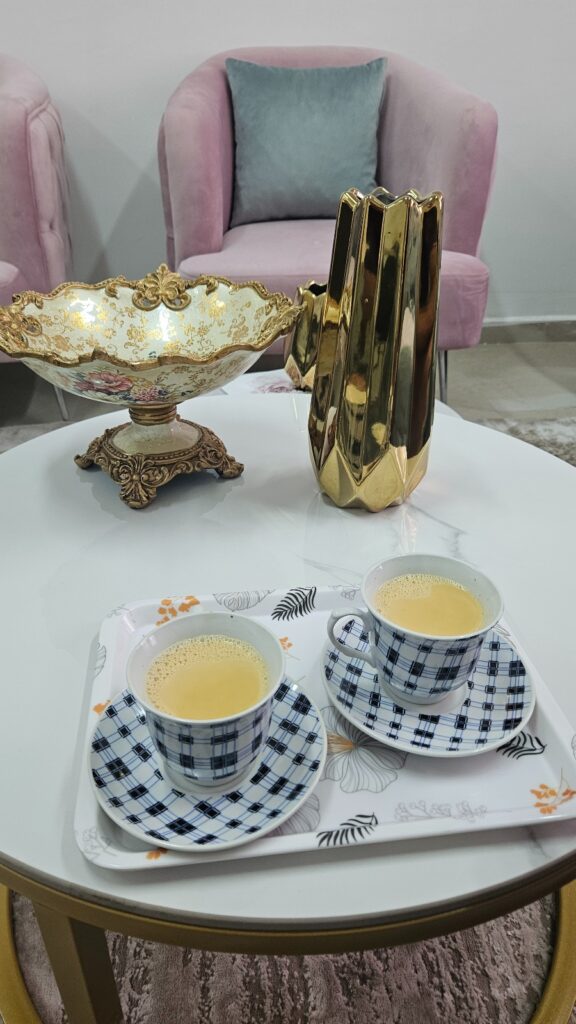
Later I found some recipes in the internet and I intend to try it at home!
Other facts about Djibouti’s snacks
Akram bought us sesame seed balls, which were tasty, and consistent, and the anecdote was that, near Lake Abbe, we had a puncture and, while we stopped to repair it under a suffocating sun (my Gosh that was hard!) a few kids appeared.
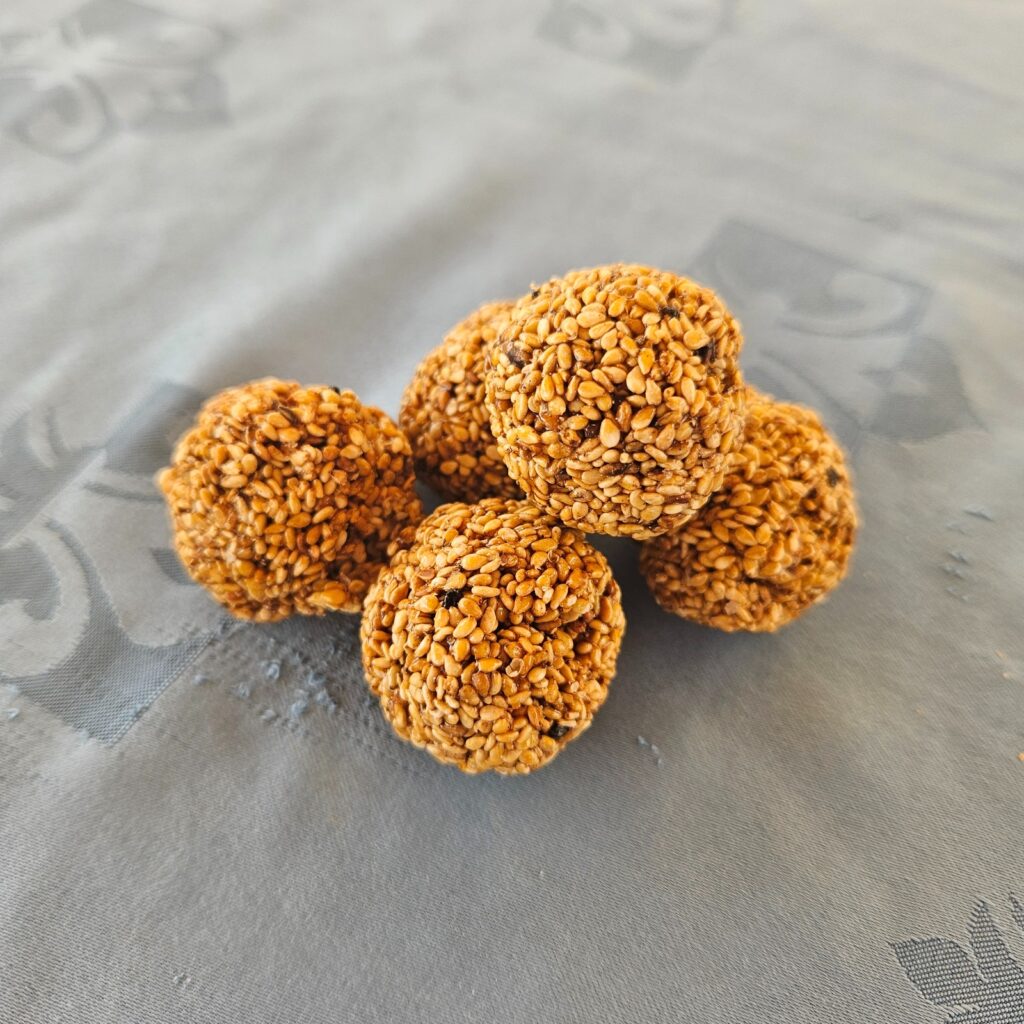
I offered sesame balls to a kid, but he refused: I think he was not comfortable with me being a woman and talking to him.
However a couple of young ladies did want them, and accepted them eagerly!
Khat
Also, let’s talk about the khat.
We saw many people chewing khat (also spelled qat or chat), a leafy plant that contains a mild stimulant called cathinone.
Chewing khat is a widespread social and cultural practice, especially among men. It’s often consumed in the afternoon or evening in group settings, accompanied by conversation, tea, or music.
Khat has mild amphetamine-like effects, including increased alertness, euphoria, and talkativeness. However, it can also lead to insomnia, loss of appetite, and—over time—dependency or health issues with excessive use.
Khat is imported daily (often from Ethiopia), and its arrival in towns can create a daily rhythm as people wait for fresh bundles. It’s typically sold in small, tied bundles of fresh green leaves.
Khat is legal and widely accepted in Djibouti, unlike in many Western countries where it is banned or controlled.
Carbohydrates
Djiboutian cuisine, influenced by Somali, Ethiopian, Yemeni, and French culinary traditions, features several carbohydrate-rich dishes. Here are some popular ones:
- Lahoh (Canjeero): A spongy, pancake-like flatbread similar to Ethiopian injera but less sour. It is often eaten with honey for breakfast or served with stews.
Anjero: Another version of flatbread, typically served during breakfast with butter and sugar or as an accompaniment to savory dishes.
Cambuulo: A dish made from adzuki beans and rice, often sweetened with sugar or honey and flavored with sesame oil.
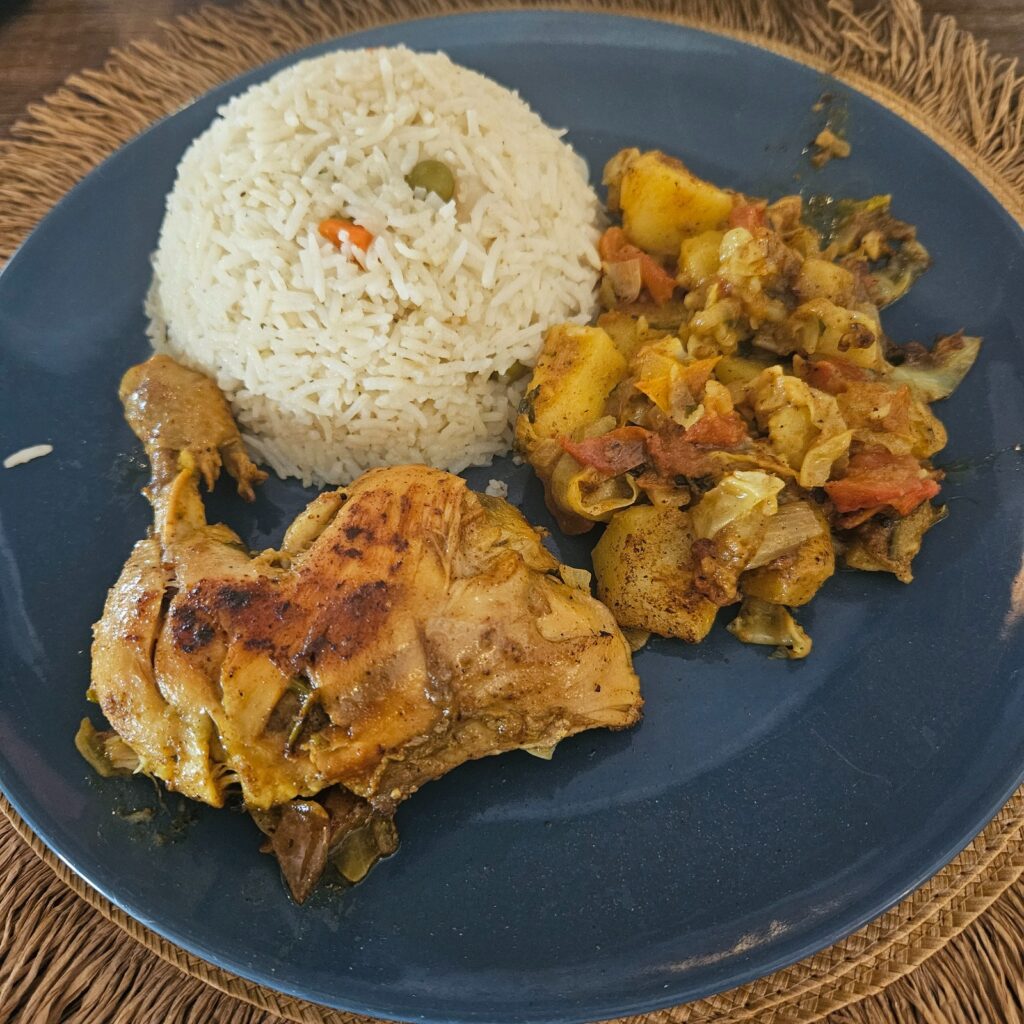
Protein Recovery
Djibuti also offers plenty of posibilities in terms of protein recovey, like:
- Fah-Fah (Djiboutian Meat Soup): A hearty soup made with chunks of beef or goat, flavored with spices such as cumin, coriander, and garlic. It often includes vegetables like carrots and potatoes.
- Skoudehkaris (Djiboutian Rice and Meat Dish): The national dish of Djibouti, made with rice, goat or lamb meat, and a blend of spices. While rice provides carbohydrates, the meat adds a substantial amount of protein.
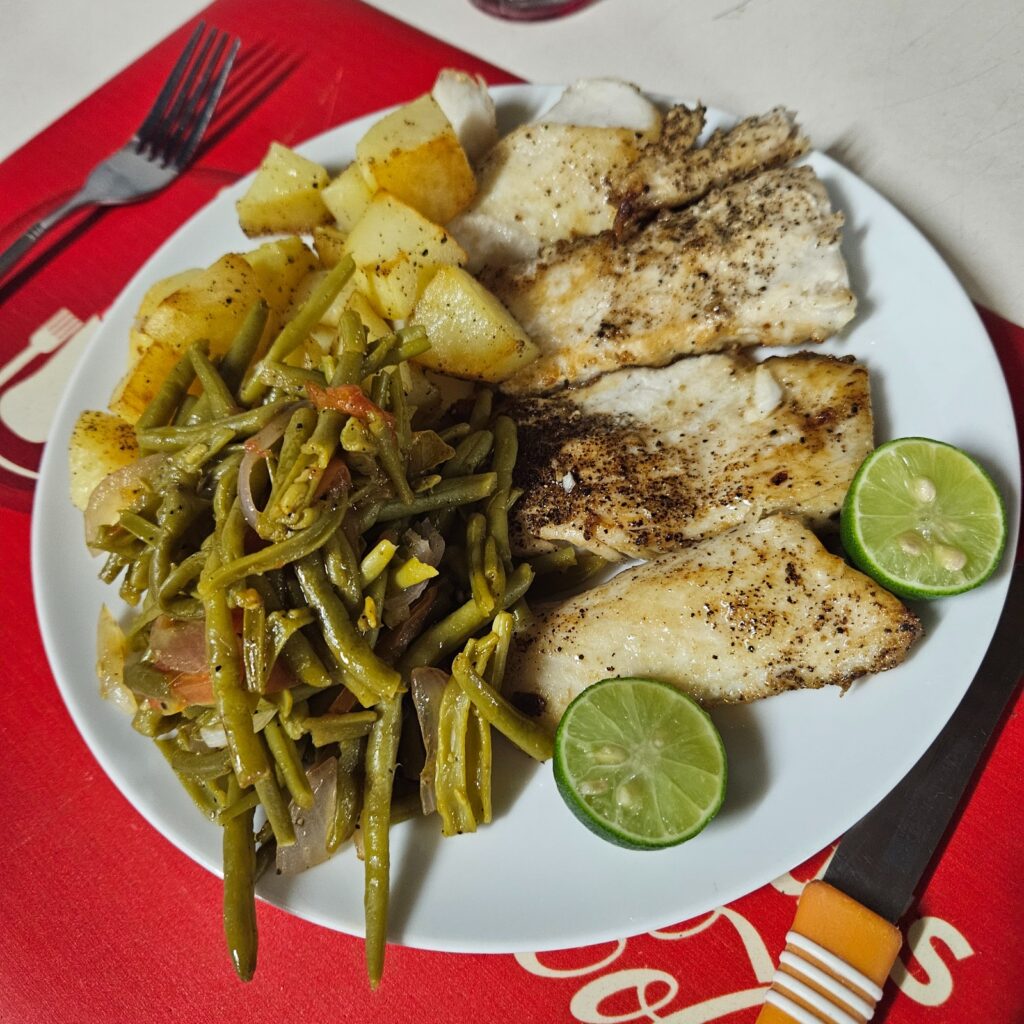
- Grilled Fish (Djiboutian Style): Fresh fish, often marinated with a blend of spices and grilled over an open flame. Served with a side of rice or salad.

Map
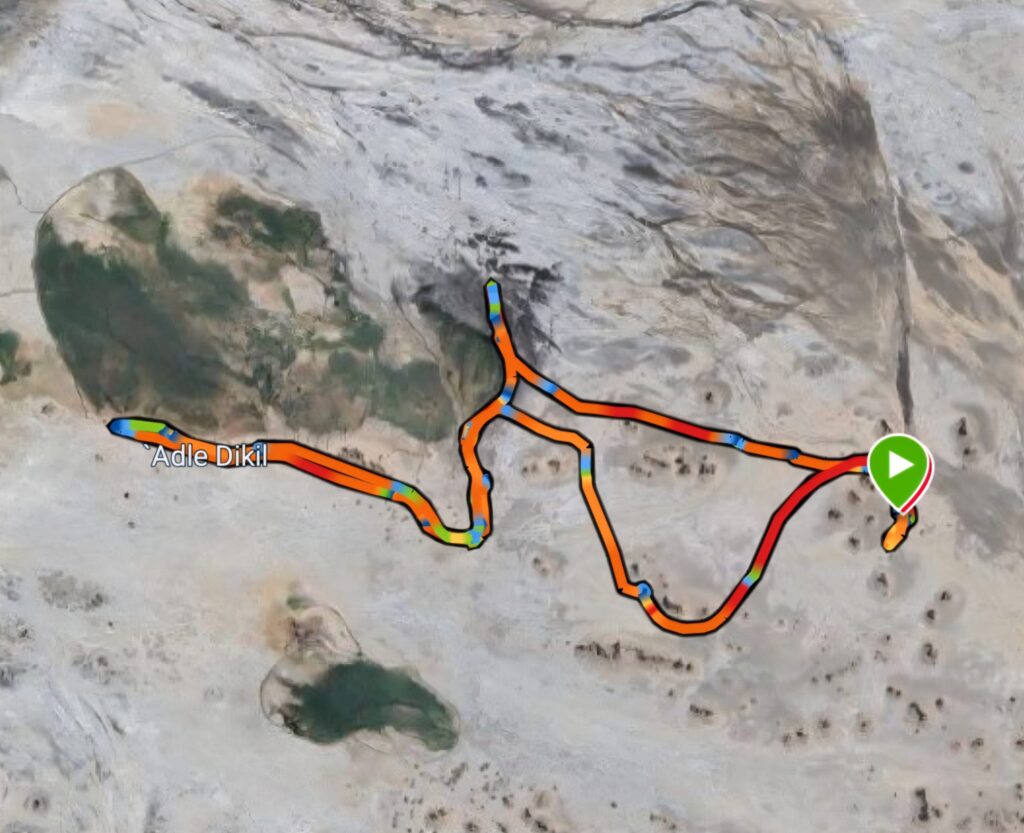
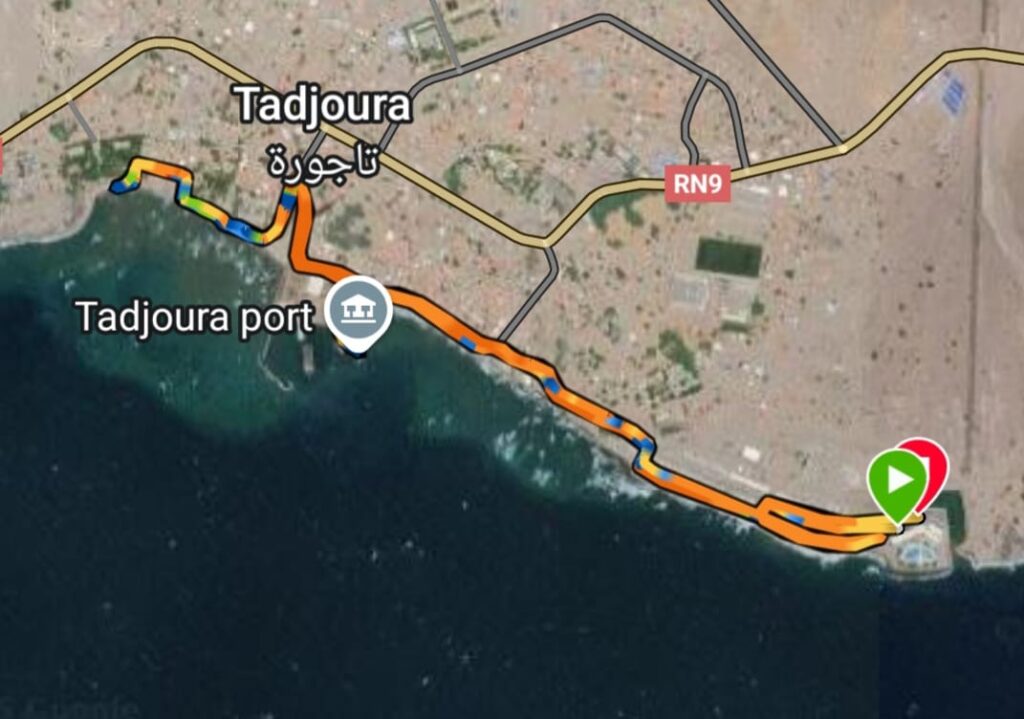

Useful information
🏃 Amazing two runs in Lake Abbe and Tadjourah, in Djibouti. Runs from 3kms to 8kms.
👟 Urban and trail: although all shoes are fine, I would advise for trail shoes better, as even in the city sometimes the terrain is uneven.
✅ Run in Lake Abbe is one of the best we ever ran. Astonishing beauty.
✅ Tadjourah with its little tourism, guarantees to offer a rare yet vibrant glimpse into daily life of people from djibouti.
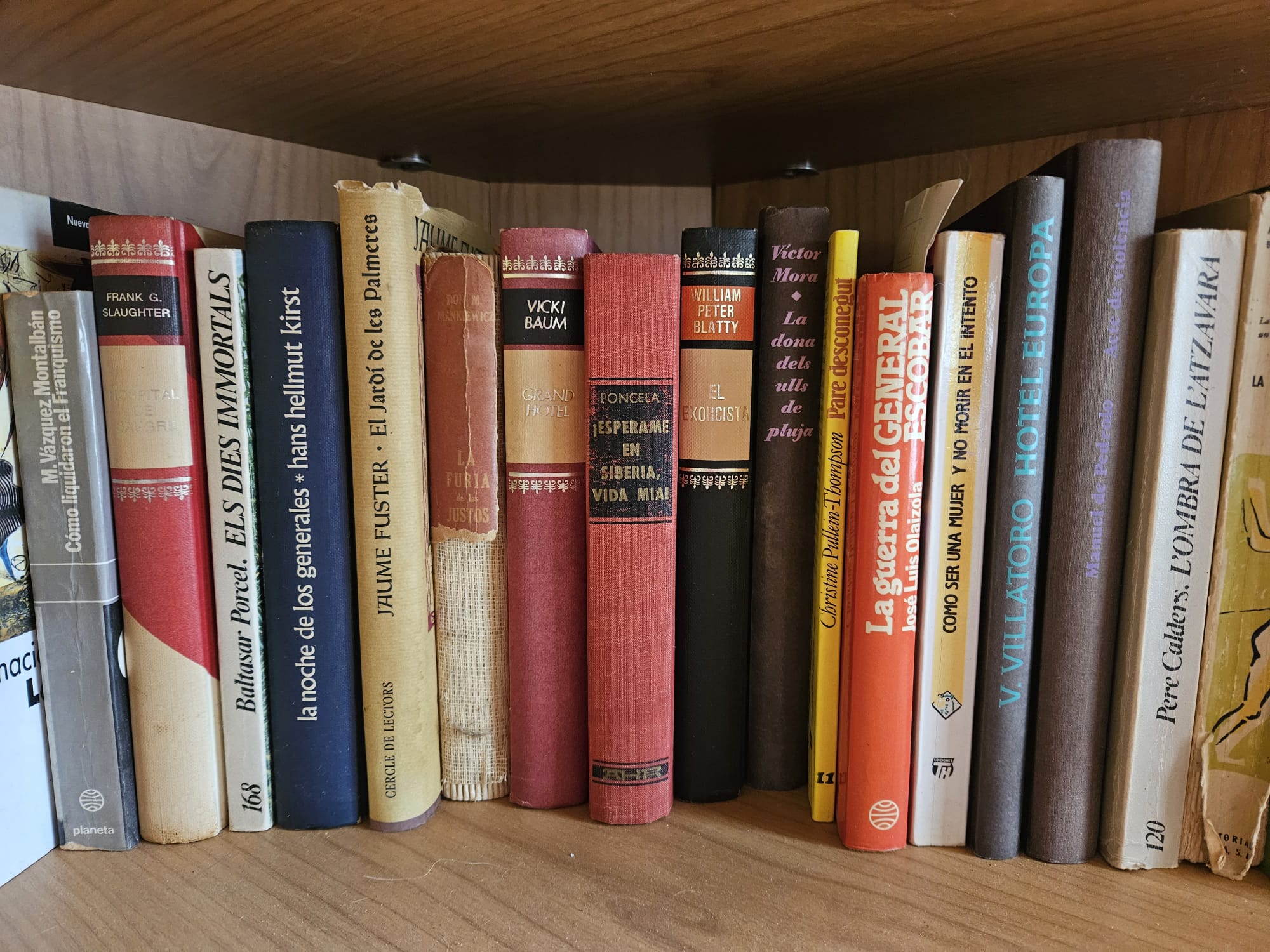
One book
In the United States of Africa, Abdourahman A. Waberi
The novel presents an alternate reality where Africa is wealthy, advanced, and dominant, while the Western world is impoverished and strife-torn.
This inversion forces readers to rethink their assumptions about race, power, and privilege.
By challenging traditional narratives of African underdevelopment and dependency, the book reclaims Africa’s place as a central figure in global storytelling.
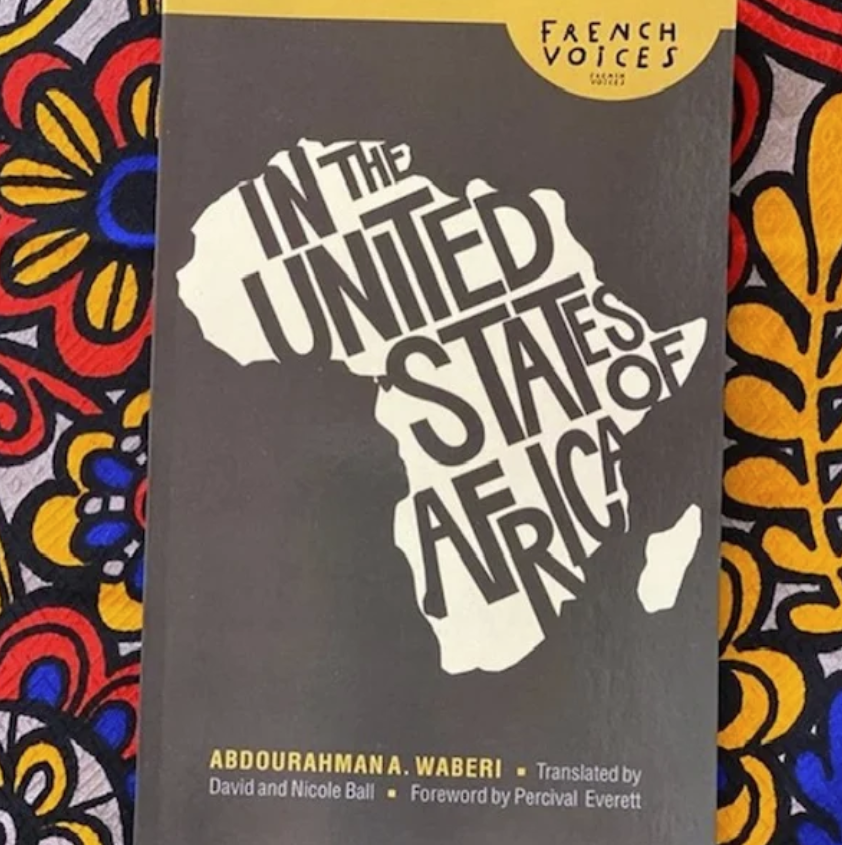
Plot Summary: In a literary reversal as deadly serious as it is wickedly satiric, this novel by the acclaimed French-speaking African writer Abdourahman A. Waberi turns the fortunes of the world upside down. On this reimagined globe a stream of sorry humanity flows from the West, from the slums of America and the squalor of Europe, to escape poverty and desperation in the prosperous United States of Africa. It is in this world that an African doctor on a humanitarian mission to France adopts a child. Now a young artist, this girl, Malaïka, travels to the troubled land of her birth in hope of finding her mother—and perhaps something of her lost self. Her search, at times funny and strange, is also deeply poignant, reminding us at every moment of the turns of fate we call truth.

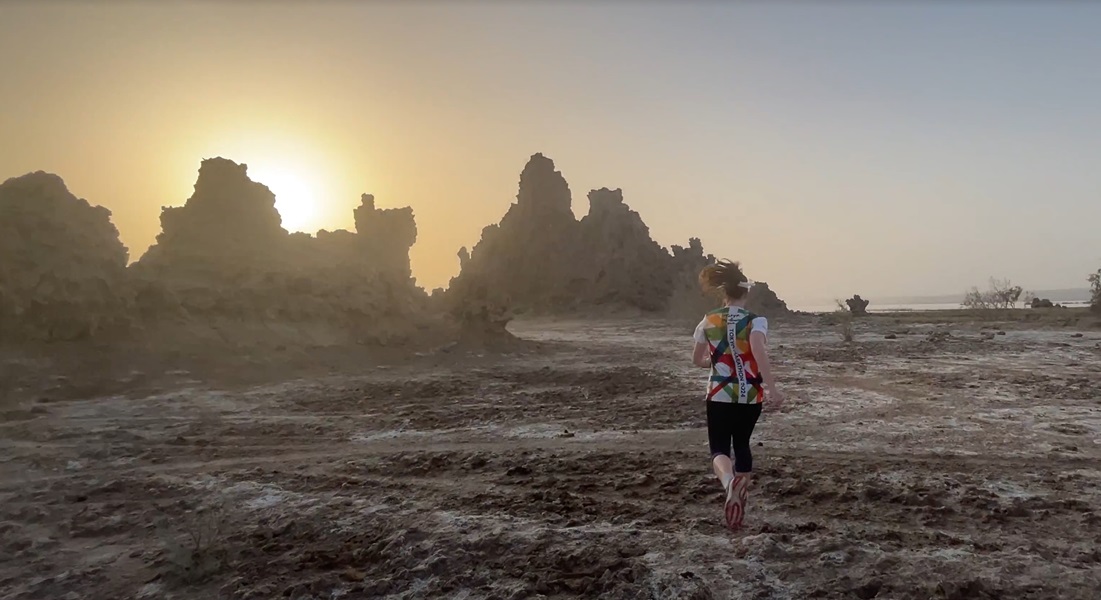
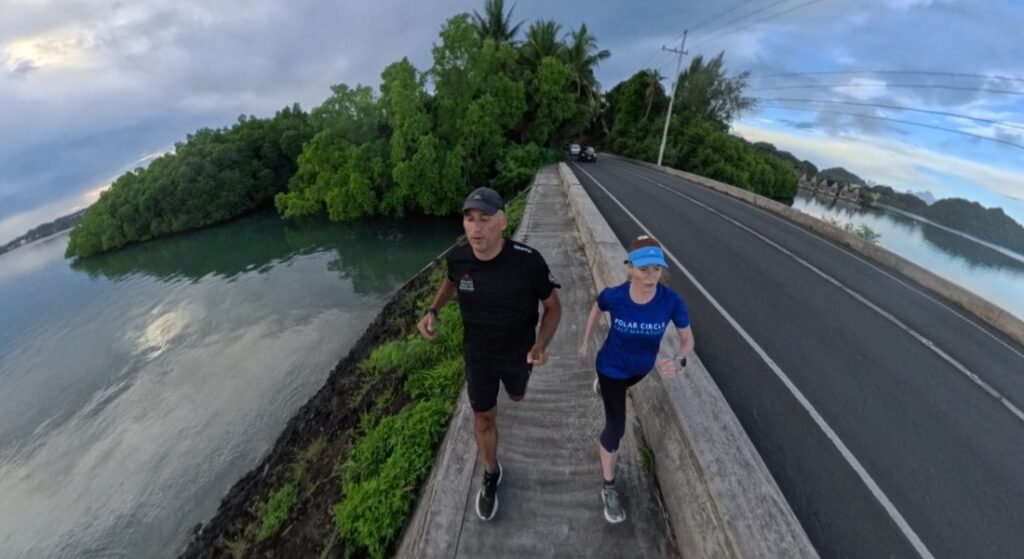

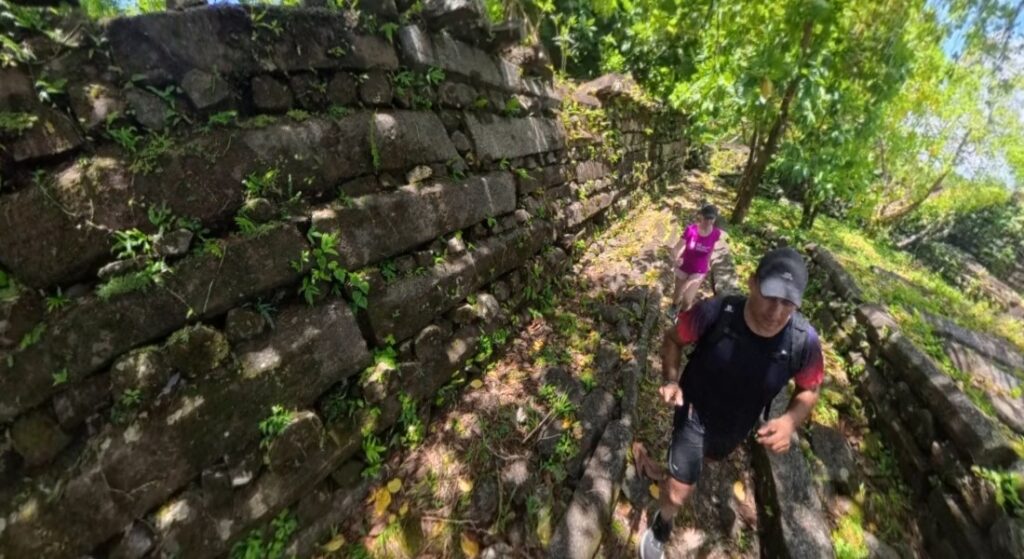
One Comment